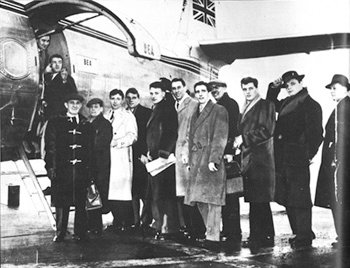Ned Ward
Monday, February the 6th, 2006
back to: title, date or indexes
Today, my thoughts turn to custard. I do not mean by this that my brain is curdling into mush, though that may well happen as the day goes on. This is, after all, early 21st century Britain, and I am assailed by twaddle and pap wherever I look. It would not be surprising if I succumbed to it and began to gibber and drool.
That is why I have concentrated my mind on custard. Let us recall the words of Ned Ward (1667-1731), who wrote “Custard, that noble cooling Food, / So toothsome, wholesome and so good, / That Dainty so approv'd of old, / Whose yellow surface shines like Gold”. Ward was a poet and a publican, described as follows in Volume IX of the first edition of The Cambridge History of English and American Literature: “He was no wizard, but a pedestrian jogtrot writer of doggerel, whom criticism could not affright nor opposition baulk. Yet his Hudibras is a wonderful achievement. Its facile fluent ease marks the versifier who could write two hundred lines standing on one foot. His language is common enough. Neither Brown nor Motteux surpasses him in knowledge of the slang which was heard in the tavern or at the street corner. Had he lived today, he might have been an ornament of the sporting press. Living when he did, he supported the cause of church and state in such couplets as jingled in the brain, and tripped readily to the tongue.”
Ned Ward
The custard-soaked quotation is from Ward's British Wonders : Or, A Poetical Description of the Several Prodigies and Most Remarkable Accidents That have happen'd in Britain since the Death of Queen Anne (1717). (Incidentally, do you lament, as I do, the passing of long, even unwieldy book-titles? Nowadays everything has to be snappy and memorable, presumably so it can be marketed by zonk-eyed bean-counters. If someone published a history of ink today, it would no doubt be called Ink!, with the obligatory subtitle The Liquid That Changed The World. When David N Carvalho addressed the topic in 1904, his book had the majestic title Forty Centuries Of Ink, Or A Chronological Narrative Concerning Ink And Its Backgrounds, Introducing Incidental Observations And Deductions, Parallels Of Time And Colour Phenomena, Bibliography, Chemistry, Poetical Effusions, Citations, Anecdotes And Curiosa Together With Some Evidence Respecting The Evanescent Character Of Most Inks Of Today And An Epitome Of Chemico-Legal Ink. Ah, those were the days.)
Ink, custard. Could custard ever be called The Yellow Goo That Changed the World? Possibly not. It is difficult to think of any earth-shattering events in which custard has played a pivotal role, or indeed any role at all. I know that I could make some up, if I so desired, but I am not going to, not today anyway, for today it seems important to cleave to the truth.
What is custard, anyway? According to the wikipedia, it is a family of preparations based on milk and eggs, thickened with heat. Most commonly, it refers to a dessert or dessert sauce, but custard bases are also used for quiches and other savoury foods. Depending on how much egg or thickener is used, custard may vary in consistency from a thin pouring sauce to a thick blancmange. Most custard is cooked in a double boiler (bain-marie) or heated very gently on the stove in a saucepan, but custard can also be steamed or baked in the oven with or without a hot water bath. Instant and ready-made ‘custards' are also marketed, though they are not true custards if they are not thickened with egg. I think we can agree that only true custard is worthy of our attention, particularly on this day devoted to truth.
Readers may wonder why, today of all days, I am so insistent on truth-telling. My reasons, I should say, are entirely non-custard-related. Exactly forty eight years ago, on the sixth of February 1958, the Busby Babes—the flower of post-war British football—were wiped out in the Munich Air Disaster. Hang your head in their memory for a moment before continuing to read.

The Busby Babes boarding the fatal aeroplane
Oh, come on, hang your head a bit longer than that!
I have never cared a jot about football myself, but my Uncle Ned was a fierce adherent of the sport. (Ned was not named after Ned Ward, by the way, in case you were wondering.) Deeply affected by the tragedy that unfolded at that blizzard-wracked German airfield, Ned cajoled our whole extended family into joining him in his annual remembrance of the crash. Throughout my childhood—throughout my life—the sixth of February has been the most significant day of the year. It means more to me than Christmas, or Easter, or even my birthday. I can blithely let feast days and holy days pass unremarked. You will find me unmoved on National Potato Day (29th January), Penguin Awareness Day (20th January) and National Punctuation Day (24th September). Yet the shade of dead Uncle Ned hovers over me on this day, and perhaps it is in homage to him, rather than to those lost young footballers, that I promise to speak only the truth, from midnight to midnight.

Thomas More
And that is why I write only of true custard, not of the wretched synthetic slop that seeks to deceive the custard-innocent palate. We would do well to remember here that Thomas More's wife (or was it his daughter?) took custards to him when he was imprisoned by King Henry VIII. Those would have been true custards, without a doubt. Admittedly, my source is semi-fictional, being an ill-remembered reading of Robert Bolt's play A Man For All Seasons. What is clear in my memory is that this was my first encounter with the construction “a custard”, as opposed to “some custard” or “a bowl of custard” or, of course, simply “custard”. I was about fourteen years old at the time, given the play to read as part of my schoolwork, and all I recall of it is the curious fascination I felt for that indefinite article. “A custard”! It was so unexpected, it made me think of custard in a new way. I tried to visualise what this centuries-old custard would have looked like. If it was not in a bowl or a dish, it must have some solid form. Was it wrapped up in a bag, a bag of wool or burlap? Years passed before I learned that the very word “custard” is derived from “crustade” which is a tart with a crust. So doomed Thomas More's custards would have been encased in pastry, I surmise.

Pierre Bonnard
One final note, not exactly about custard, but about yellow, the colour of custard. However pale it may be, true custard has at least a yellow tinge. The French painter Pierre Bonnard once remarked “Ah, yellow! I can't get enough of it!” Readers, can you say the same for custard?
Hooting Yard on the Air, February the 22nd, 2006 : “The Ogsby Steering Panel” (starts around 20:42)